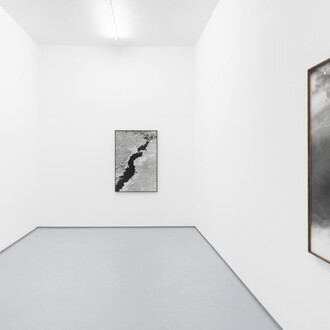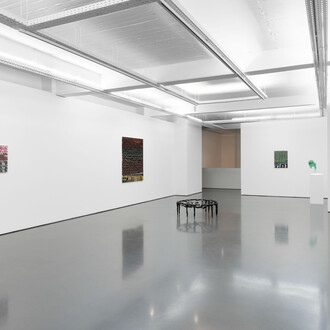The architecture and urbanism have always been reference subjects for Rodrigo Oliveira’s work (Sintra, 1978), explored in a variety of mediums, predominantly sculpture and installation, but still with a strong, intense and wide chromatism. However, painting has never been the chosen register. “Sex, shadow boxing and a wall” the title of the sixth solo exhibition of the artist at Galeria Filomena Soares, shows an installation, sculptures and 100 paintings on wooden card in a game of lenses - sometimes enlarging, others occulting - with images from the traditional Japanese prints Shunga (spring pictures) and the Namban folding screens.
Between 1600 and 1900 in Japan thousands of paintings, engravings and illustrated books were produced with explicit sex scenes; almost always tender, playful and beautiful, these images convey a positive and free sense of sexual pleasure, accessible to all. Although the Japanese regime of these centuries was based on strict laws following the doctrine of Confucius, private life in practice was less controlled, and Shunga production is a unique phenomenon in artistic pre-modern output not only concerning quantity and quality but above all for its erotic theme.
What makes Rodrigo Oliveira's series "Between Four Walls" at various levels remarkable and a milestone in its journey, is as part of a temporal and cultural period, distinct from his previous works in which modernism was the reference and the culture was the western one. Now the referents are from the seventeenth and eighteenth century and the Orient. As if this were not enough, he decides not for sculpture and installation, languages that we identify with his production - and that are also present in the exhibition - but for painting, more precisely watercolors.
Through the past two years he painted obsessively and devotionally almost as if one was praying or repeating a litany, these papers, whose motives were taken from the Shunga painting but in which the bodies and explicit sexual content were removed, the phalluses and genitals of these "paintings of spring " in which lifeblood and other liquids flow; leaving only the floor, the ceiling, the stripes, the floral or geometric patterns of the typical walls of Japanese architecture, flowers, birds, garden, a blind, a Pagoda. Although they refer to domestic or interior environments of houses, they resemble stages, scenographies for sexual acts that, now omitted, install in these watercolors a double sensuality: that of painting itself, the meticulous and delicate act of painting and the withdrawing bodies, softly and gently removed leaving only their surroundings.
Not only is painting a cosa mentale, but also sex becomes - if it is not always - cosa mentale, now that we do not have access to its representation and figuration, and it remains only a pair of slippers remain, barefooted in a haste, we think, by the form they are misaligned on the floor; a tree stump, now a table with a precisely layed object, a pipe? The accumulation of pleasures, smoking after sex ... Only this is left in these works, but our imagination shoots in various fantasies of what could have been represented in the paintings from which these arises.
In aesthetic terms, they seem to come out of a comic book, namely Hergé's Tintin in the way the line is very well defined, the famous clear line that is not only a graphic style but also narrative, readable, in which the drawing rests on what it wants to count. Thus, in "Between Four Walls," what now seems it wants to tell, are stories of spaces and architectures, stories of walls that have received bodies in light colors ranging from the softness ocher and roses to other bright colors, yellow and saturated reds that suggest pop art. In the process of these paintings, Rodrigo Oliveira arrives at the Namban folding screens, more precisely painting the details of the backs of the screens, painting what is behind, the hidden and reaches an almost monochromatic, atmospheric register. Not by chance the word Namban in Japanese means “wall”. A wall, literally a wall is the work that can be seen in the second room, entitled "Transladação" shown for the first time in Madrid in the Project Rooms of Arco art fair in 2018. And here we are in what is the territory with which we identify the work of Oliveira: architecture and modernism as references. "Transladação" refers to the passage of time, the moss and water of many modern places-spaces today abandoned, ruins, archeology of the modern.
And to unite the before and after the "Diabolos", sculptures that depart from the lamps designed by Corbusier and now revisited with materials of much more prosaic origins and of daily use, another characteristic of Oliveira's work, like the old measuring cups that are used (or were used) in grocery stores to move and measure cereals and now display lamps.
And to unite everything, the postcard that Walter Gropius wrote to Corbusier in Japan in 1954 and there is a temple with a Japanese Zen garden in Kyoto and the words of those who feel excited, literally "excited", in front of the encounter with the Japanese architecture and culture.
"Sex, Shadow boxing and a Wall" is an exhibition that recalls the excitement of the first encounters, be it the awakening of sexuality in the play of Hide and Seek in which the bodies hide and touch or others more elaborated like the intellectual pleasure facing a building or a painting.
















